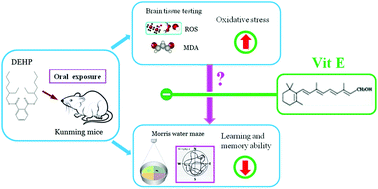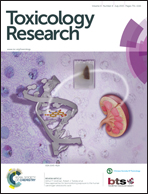Neurobehavioral changes induced by di(2-ethylhexyl) phthalate and the protective effects of vitamin E in Kunming mice
Abstract
Di(2-ethylhexyl) phthalate (DEHP) is a plasticizer commonly used in PVC that may leach into the environment, and has been shown to adversely affect the health of humans and animals. We undertook a study to ascertain the neurotoxicity of DEHP in Kunming mice. This study included three rounds of testing. In the first round, Kunming mice were exposed to different concentrations of DEHP (0, 5, 50, 500 mg kg−1 per day) after which their cognitive ability was assessed using the Morris water maze (MWM) test. The reactive oxygen species (ROS) content in tissue and the malondialdehyde (MDA) content of brains were also measured. In the second round, vitamin E (50 mg kg−1 per day) was given daily as an anti-oxidant via the intragastric route. Cognitive deficits and locomotor activity, as well as ROS and MDA contents were tested employing the same methods. In the third round, the depressive mood of mice after DEHP exposure (500 mg kg−1 per day) was measured using the open field test, the tail suspension test, and the forced swim test. The main findings of this study include: (1) a statistical association exists between DEHP oral exposure and spatial learning (DEHP 500 mg kg−1 per day) and memory (DEHP 50 mg kg−1 per day) dysfunction as ascertained by an MWM test of Kunming mice. (2) A statistical association was also found between DEHP oral exposure (50 and 500 mg kg−1 per day) and oxidative stress (ROS and MDA) of mouse brain tissue. (3) Co-administration of vitamin E (50 mg kg−1 per day) diminishes the elevation of ROS and MDA induced by DEHP (50 mg kg−1 per day) from significant levels to non-significant levels. (4) Co-administration of vitamin E (50 mg kg−1 per day) protects against mouse memory dysfunction induced by DEHP (50 mg kg−1 per day) from being significant to being not significant. (5) In the 5 mg kg−1 per day DEHP exposure groups, oxidative stress in brain tissue, and neurobehavioral changes were not found. (6) High dose DEHP exposure (500 mg kg−1 per day) may induce behavioral despair in mice. Conclusions: These data suggest that DEHP is neurotoxic with regard to cognitive ability and locomotor activity.


 Please wait while we load your content...
Please wait while we load your content...